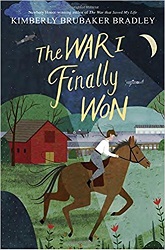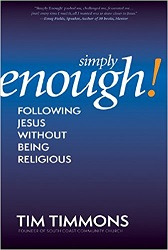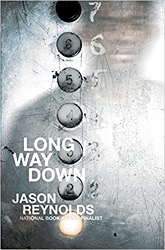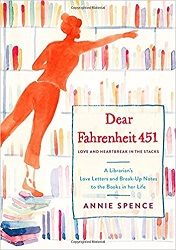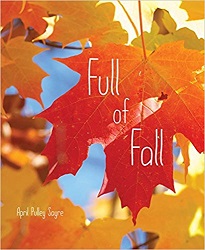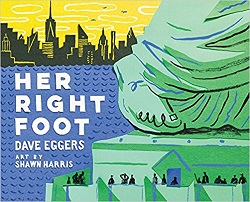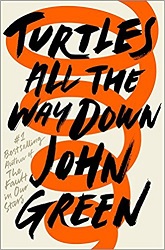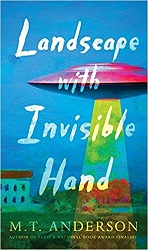 Landscape with Invisible Hand
Landscape with Invisible Hand
by M. T. Anderson
Candlewick Press, 2017. 149 pages.
Starred Review
M. T. Anderson does it again. He’s written a science fiction story that skewers our current society and culture in hard-hitting ways. Feed was brilliant. Landscape with Invisible Hand is an artistic masterpiece.
Not that it’s cheery. But this was the wrong book to choose for my Silent Book Club, because I wanted to shout with laughter and had to settle for snorts (not as satisfying). M. T. Anderson’s humor is clever and subtle – and hilarious. I won’t be able to explain the humor well in this review (you have to be there), but trust me, this book is a hoot.
The premise is that aliens have come to earth:
We were all surprised when the vuvv landed the first time. They’d been watching us since the 1940s, and we’d seen them occasionally, but we had all imagined them differently. They weren’t slender and delicate, and they weren’t humanoid at all. They looked more like granite coffee tables: squat, wide, and rocky. We were just glad they weren’t invading. We couldn’t believe our luck when they offered us their tech and invited us to be part of their Interspecies Co-Prosperity Alliance. They announced that they could end all work forever and cure all disease, so of course, the leaders of the world all rushed to sign up.
But it’s clear that Adam and his family aren’t doing well. He explains how things went:
Almost no one had work since the vuvv came. They promised us tech that would heal all disease and would do all our work for us, but of course no one thought about the fact that all that tech would be owned by someone and would be behind a paywall. The world’s leaders met with the vuvv, after meeting with national Chambers of Commerce and various lobbyists. The vuvv happily sold their knowledge to captains of industry in exchange for rights to the Earth’s electromagnetic energy fields and some invisible quantum events. Next thing we knew, vuvv tech was replacing workers all over the world. At first, it was just manual labor, factory labor. Show tech a product – a shirt, a swing set, a subdivision – and in minutes tech could make it from trash. No reason for an assembly line for workers. We watched a billion people around the globe lose their jobs in just a year or two. My parents thought they were safe, white-collar.
My mom was a bank teller. Most of her work was already done by ATMs, even before the vuvv came, and what was left required someone who could listen, think, decide, and verify. But within six months of the vuvv landing, she was fired. Almost all bank tellers were fired, and so was everyone else who did paperwork and customer interface in any other business. Vuvv tech did it all now – a computerized voice purring, “Let me help you with that”; “I’m sorry, but your account is already overdrawn”; “Very funny, Mr. Costello. I always appreciate a little sarcasm at day’s end.”
The human economy collapsed. No human currency could stand up against the vuvv’s ch’ch. The lowliest vuvv grunt made more in a week than most humans made in two years. Only the wealthiest of humans could compete, once they had a contract for vuvv tech, once they could invest in vuvv firms.
My father thought that his job was safe. He was a Ford salesman. There was no way, he said, that he could be replaced by a computer, because salesmen need that human touch, that twinkle in the eye. It turned out, however, that no one could afford a new car anyway.
Fortunately, Adam has found a way to support his family. The vuvv were watching earth in the 1950s and they had become enamored with human teen romance – as it was seen in 1950s films. The vuvv don’t reproduce the same way as humans – they bud to produce their spawn. But they loved to watch humans in love. So Adam and Chloe got hooked up to some tech and did all their dates on pay-per-minute with thousands of vuvv viewers.
The only problem: After a while of this, Adam and Chloe hate each other. And Adam has Merrick’s Disease, “a stomach syndrome I caught from our untreated tap water – as part of the vuvv’s austerity measures, municipal water is no longer purified.” Chloe doesn’t find this attractive, nor is it particularly pleasant for Adam. Too bad he can’t afford vuvv medicine.
And did I mention? The rich – the ones who can afford vuvv technology – live in floating cities while the rest of humanity lives in squalor trying to figure out how to buy food. Adam’s mom keeps relentlessly looking for work. “You have to hold onto hope!” His father left them, and renting out part of the house was how Chloe’s family came to live downstairs.
But Adam is an artist. And the vuvv have taken interest in human art. They have a huge contest for teenage human spawn in art and music. If Adam can win, it will change everything. But the vuvv seem to prefer still life depictions, which they believe is traditional human art. Will Adam conform and maybe win, or will he tell the truth with his art?
Believe it or not, this short and bleak-sounding book is full of clever laugh-out-loud moments. I love the traditional vuvv greeting, “You appear fertile, as if you could bud many spawn.”
Here’s the description of one of Adam and Chloe’s episodes, translated into vuvv:
Ocean Memories: Humans Adam and Chloe are going to the beach now! They are in true love. They have playful splashing. The water is too cold for organism Adam and he squeals like a piggy, says loving Chloe! Humans find the oscillating presence of hundreds of billions of gallons of a chemical that could smother them relaxing. This leads to cuddles in mounds of finely ground particulate detritus. “I’ll always be true,” says Adam!
And – M. T. Anderson does pull off this novel with an ending that leaves you satisfied, rather than horribly depressed (as you’re afraid might happen). I just have to say this, though: As our technology improves, let’s not treat any of our fellow humans as if we were vuvv and don’t even care if they live or die. (Wait, should I not spell it out?)
Even if you don’t take any message out of the book, this is a supremely entertaining story, masterfully carried out.
candlewick.com
Buy from Amazon.com
Find this review on Sonderbooks at: www.sonderbooks.com/Teens/landscape_with_invisible_hand.html
Disclosure: I am an Amazon Affiliate, and will earn a small percentage if you order a book on Amazon after clicking through from my site.
Source: This review is based on a library book from Fairfax County Public Library.
Disclaimer: I am a professional librarian, but I maintain my website and blogs on my own time. The views expressed are solely my own, and in no way represent the official views of my employer or of any committee or group of which I am part.
What did you think of this book?
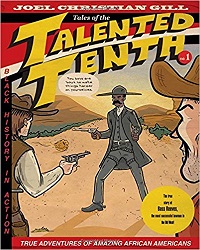 Tales of the Talented Tenth, No. 1
Tales of the Talented Tenth, No. 1
